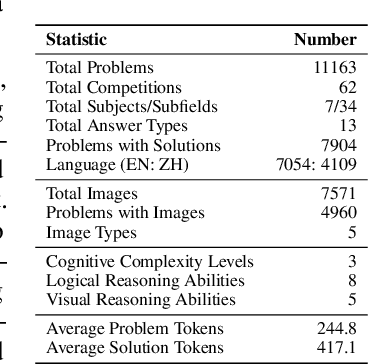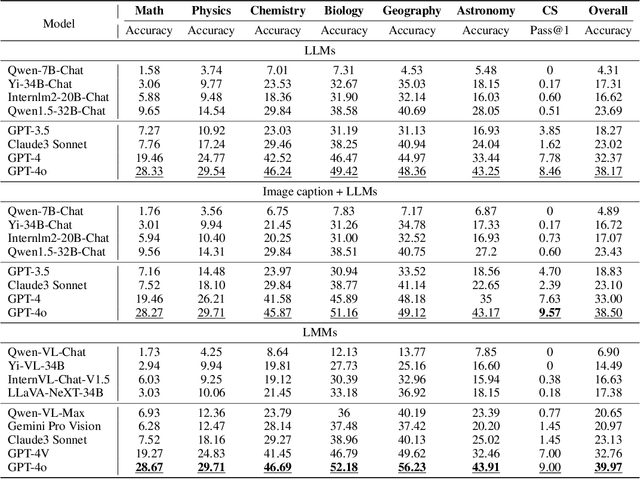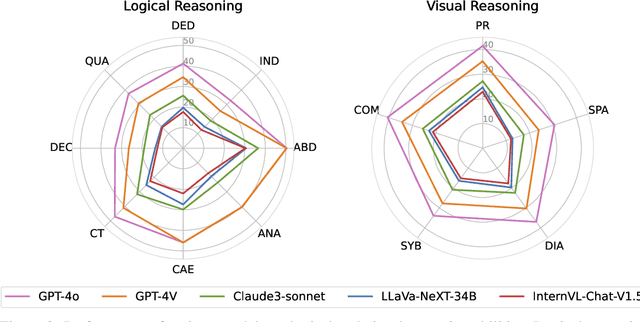Yan Ma
Visual Programmability: A Guide for Code-as-Thought in Chart Understanding
Sep 11, 2025Abstract:Chart understanding presents a critical test to the reasoning capabilities of Vision-Language Models (VLMs). Prior approaches face critical limitations: some rely on external tools, making them brittle and constrained by a predefined toolkit, while others fine-tune specialist models that often adopt a single reasoning strategy, such as text-based chain-of-thought (CoT). The intermediate steps of text-based reasoning are difficult to verify, which complicates the use of reinforcement-learning signals that reward factual accuracy. To address this, we propose a Code-as-Thought (CaT) approach to represent the visual information of a chart in a verifiable, symbolic format. Our key insight is that this strategy must be adaptive: a fixed, code-only implementation consistently fails on complex charts where symbolic representation is unsuitable. This finding leads us to introduce Visual Programmability: a learnable property that determines if a chart-question pair is better solved with code or direct visual analysis. We implement this concept in an adaptive framework where a VLM learns to choose between the CaT pathway and a direct visual reasoning pathway. The selection policy of the model is trained with reinforcement learning using a novel dual-reward system. This system combines a data-accuracy reward to ground the model in facts and prevent numerical hallucination, with a decision reward that teaches the model when to use each strategy, preventing it from defaulting to a single reasoning mode. Experiments demonstrate strong and robust performance across diverse chart-understanding benchmarks. Our work shows that VLMs can be taught not only to reason but also how to reason, dynamically selecting the optimal reasoning pathway for each task.
MiniMax-M1: Scaling Test-Time Compute Efficiently with Lightning Attention
Jun 16, 2025Abstract:We introduce MiniMax-M1, the world's first open-weight, large-scale hybrid-attention reasoning model. MiniMax-M1 is powered by a hybrid Mixture-of-Experts (MoE) architecture combined with a lightning attention mechanism. The model is developed based on our previous MiniMax-Text-01 model, which contains a total of 456 billion parameters with 45.9 billion parameters activated per token. The M1 model natively supports a context length of 1 million tokens, 8x the context size of DeepSeek R1. Furthermore, the lightning attention mechanism in MiniMax-M1 enables efficient scaling of test-time compute. These properties make M1 particularly suitable for complex tasks that require processing long inputs and thinking extensively. MiniMax-M1 is trained using large-scale reinforcement learning (RL) on diverse problems including sandbox-based, real-world software engineering environments. In addition to M1's inherent efficiency advantage for RL training, we propose CISPO, a novel RL algorithm to further enhance RL efficiency. CISPO clips importance sampling weights rather than token updates, outperforming other competitive RL variants. Combining hybrid-attention and CISPO enables MiniMax-M1's full RL training on 512 H800 GPUs to complete in only three weeks, with a rental cost of just $534,700. We release two versions of MiniMax-M1 models with 40K and 80K thinking budgets respectively, where the 40K model represents an intermediate phase of the 80K training. Experiments on standard benchmarks show that our models are comparable or superior to strong open-weight models such as the original DeepSeek-R1 and Qwen3-235B, with particular strengths in complex software engineering, tool utilization, and long-context tasks. We publicly release MiniMax-M1 at https://github.com/MiniMax-AI/MiniMax-M1.
Thinking with Generated Images
May 28, 2025Abstract:We present Thinking with Generated Images, a novel paradigm that fundamentally transforms how large multimodal models (LMMs) engage with visual reasoning by enabling them to natively think across text and vision modalities through spontaneous generation of intermediate visual thinking steps. Current visual reasoning with LMMs is constrained to either processing fixed user-provided images or reasoning solely through text-based chain-of-thought (CoT). Thinking with Generated Images unlocks a new dimension of cognitive capability where models can actively construct intermediate visual thoughts, critique their own visual hypotheses, and refine them as integral components of their reasoning process. We demonstrate the effectiveness of our approach through two complementary mechanisms: (1) vision generation with intermediate visual subgoals, where models decompose complex visual tasks into manageable components that are generated and integrated progressively, and (2) vision generation with self-critique, where models generate an initial visual hypothesis, analyze its shortcomings through textual reasoning, and produce refined outputs based on their own critiques. Our experiments on vision generation benchmarks show substantial improvements over baseline approaches, with our models achieving up to 50% (from 38% to 57%) relative improvement in handling complex multi-object scenarios. From biochemists exploring novel protein structures, and architects iterating on spatial designs, to forensic analysts reconstructing crime scenes, and basketball players envisioning strategic plays, our approach enables AI models to engage in the kind of visual imagination and iterative refinement that characterizes human creative, analytical, and strategic thinking. We release our open-source suite at https://github.com/GAIR-NLP/thinking-with-generated-images.
One RL to See Them All: Visual Triple Unified Reinforcement Learning
May 23, 2025Abstract:Reinforcement learning (RL) has significantly advanced the reasoning capabilities of vision-language models (VLMs). However, the use of RL beyond reasoning tasks remains largely unexplored, especially for perceptionintensive tasks like object detection and grounding. We propose V-Triune, a Visual Triple Unified Reinforcement Learning system that enables VLMs to jointly learn visual reasoning and perception tasks within a single training pipeline. V-Triune comprises triple complementary components: Sample-Level Data Formatting (to unify diverse task inputs), Verifier-Level Reward Computation (to deliver custom rewards via specialized verifiers) , and Source-Level Metric Monitoring (to diagnose problems at the data-source level). We further introduce a novel Dynamic IoU reward, which provides adaptive, progressive, and definite feedback for perception tasks handled by V-Triune. Our approach is instantiated within off-the-shelf RL training framework using open-source 7B and 32B backbone models. The resulting model, dubbed Orsta (One RL to See Them All), demonstrates consistent improvements across both reasoning and perception tasks. This broad capability is significantly shaped by its training on a diverse dataset, constructed around four representative visual reasoning tasks (Math, Puzzle, Chart, and Science) and four visual perception tasks (Grounding, Detection, Counting, and OCR). Subsequently, Orsta achieves substantial gains on MEGA-Bench Core, with improvements ranging from +2.1 to an impressive +14.1 across its various 7B and 32B model variants, with performance benefits extending to a wide range of downstream tasks. These results highlight the effectiveness and scalability of our unified RL approach for VLMs. The V-Triune system, along with the Orsta models, is publicly available at https://github.com/MiniMax-AI.
Generative AI Act II: Test Time Scaling Drives Cognition Engineering
Apr 21, 2025Abstract:The first generation of Large Language Models - what might be called "Act I" of generative AI (2020-2023) - achieved remarkable success through massive parameter and data scaling, yet exhibited fundamental limitations such as knowledge latency, shallow reasoning, and constrained cognitive processes. During this era, prompt engineering emerged as our primary interface with AI, enabling dialogue-level communication through natural language. We now witness the emergence of "Act II" (2024-present), where models are transitioning from knowledge-retrieval systems (in latent space) to thought-construction engines through test-time scaling techniques. This new paradigm establishes a mind-level connection with AI through language-based thoughts. In this paper, we clarify the conceptual foundations of cognition engineering and explain why this moment is critical for its development. We systematically break down these advanced approaches through comprehensive tutorials and optimized implementations, democratizing access to cognition engineering and enabling every practitioner to participate in AI's second act. We provide a regularly updated collection of papers on test-time scaling in the GitHub Repository: https://github.com/GAIR-NLP/cognition-engineering
Rethinking RL Scaling for Vision Language Models: A Transparent, From-Scratch Framework and Comprehensive Evaluation Scheme
Apr 03, 2025Abstract:Reinforcement learning (RL) has recently shown strong potential in improving the reasoning capabilities of large language models and is now being actively extended to vision-language models (VLMs). However, existing RL applications in VLMs often rely on heavily engineered frameworks that hinder reproducibility and accessibility, while lacking standardized evaluation protocols, making it difficult to compare results or interpret training dynamics. This work introduces a transparent, from-scratch framework for RL in VLMs, offering a minimal yet functional four-step pipeline validated across multiple models and datasets. In addition, a standardized evaluation scheme is proposed to assess training dynamics and reflective behaviors. Extensive experiments on visual reasoning tasks uncover key empirical findings: response length is sensitive to random seeds, reflection correlates with output length, and RL consistently outperforms supervised fine-tuning (SFT) in generalization, even with high-quality data. These findings, together with the proposed framework, aim to establish a reproducible baseline and support broader engagement in RL-based VLM research.
Weak-to-Strong Reasoning
Jul 18, 2024Abstract:When large language models (LLMs) exceed human-level capabilities, it becomes increasingly challenging to provide full-scale and accurate supervisions for these models. Weak-to-strong learning, which leverages a less capable model to unlock the latent abilities of a stronger model, proves valuable in this context. Yet, the efficacy of this approach for complex reasoning tasks is still untested. Furthermore, tackling reasoning tasks under the weak-to-strong setting currently lacks efficient methods to avoid blindly imitating the weak supervisor including its errors. In this paper, we introduce a progressive learning framework that enables the strong model to autonomously refine its training data, without requiring input from either a more advanced model or human-annotated data. This framework begins with supervised fine-tuning on a selective small but high-quality dataset, followed by preference optimization on contrastive samples identified by the strong model itself. Extensive experiments on the GSM8K and MATH datasets demonstrate that our method significantly enhances the reasoning capabilities of Llama2-70b using three separate weak models. This method is further validated in a forward-looking experimental setup, where Llama3-8b-instruct effectively supervises Llama3-70b on the highly challenging OlympicArena dataset. This work paves the way for a more scalable and sophisticated strategy to enhance AI reasoning powers. All relevant code and resources are available in \url{https://github.com/GAIR-NLP/weak-to-strong-reasoning}.
ANOLE: An Open, Autoregressive, Native Large Multimodal Models for Interleaved Image-Text Generation
Jul 08, 2024Abstract:Previous open-source large multimodal models (LMMs) have faced several limitations: (1) they often lack native integration, requiring adapters to align visual representations with pre-trained large language models (LLMs); (2) many are restricted to single-modal generation; (3) while some support multimodal generation, they rely on separate diffusion models for visual modeling and generation. To mitigate these limitations, we present Anole, an open, autoregressive, native large multimodal model for interleaved image-text generation. We build Anole from Meta AI's Chameleon, adopting an innovative fine-tuning strategy that is both data-efficient and parameter-efficient. Anole demonstrates high-quality, coherent multimodal generation capabilities. We have open-sourced our model, training framework, and instruction tuning data.
MMLongBench-Doc: Benchmarking Long-context Document Understanding with Visualizations
Jul 01, 2024Abstract:Understanding documents with rich layouts and multi-modal components is a long-standing and practical task. Recent Large Vision-Language Models (LVLMs) have made remarkable strides in various tasks, particularly in single-page document understanding (DU). However, their abilities on long-context DU remain an open problem. This work presents MMLongBench-Doc, a long-context, multi-modal benchmark comprising 1,062 expert-annotated questions. Distinct from previous datasets, it is constructed upon 130 lengthy PDF-formatted documents with an average of 49.4 pages and 20,971 textual tokens. Towards comprehensive evaluation, answers to these questions rely on pieces of evidence from (1) different sources (text, image, chart, table, and layout structure) and (2) various locations (i.e. page number). Moreover, 33.2% of the questions are cross-page questions requiring evidence across multiple pages. 22.8% of the questions are designed to be unanswerable for detecting potential hallucinations. Experiments on 14 LVLMs demonstrate that long-context DU greatly challenges current models. Notably, the best-performing model, GPT-4o, achieves an F1 score of only 42.7%, while the second-best, GPT-4V, scores 31.4%. Furthermore, 12 LVLMs (all except GPT-4o and GPT-4V) even present worse performance than their LLM counterparts which are fed with lossy-parsed OCR documents. These results validate the necessity of future research toward more capable long-context LVLMs. Project Page: https://mayubo2333.github.io/MMLongBench-Doc
OlympicArena: Benchmarking Multi-discipline Cognitive Reasoning for Superintelligent AI
Jun 18, 2024



Abstract:The evolution of Artificial Intelligence (AI) has been significantly accelerated by advancements in Large Language Models (LLMs) and Large Multimodal Models (LMMs), gradually showcasing potential cognitive reasoning abilities in problem-solving and scientific discovery (i.e., AI4Science) once exclusive to human intellect. To comprehensively evaluate current models' performance in cognitive reasoning abilities, we introduce OlympicArena, which includes 11,163 bilingual problems across both text-only and interleaved text-image modalities. These challenges encompass a wide range of disciplines spanning seven fields and 62 international Olympic competitions, rigorously examined for data leakage. We argue that the challenges in Olympic competition problems are ideal for evaluating AI's cognitive reasoning due to their complexity and interdisciplinary nature, which are essential for tackling complex scientific challenges and facilitating discoveries. Beyond evaluating performance across various disciplines using answer-only criteria, we conduct detailed experiments and analyses from multiple perspectives. We delve into the models' cognitive reasoning abilities, their performance across different modalities, and their outcomes in process-level evaluations, which are vital for tasks requiring complex reasoning with lengthy solutions. Our extensive evaluations reveal that even advanced models like GPT-4o only achieve a 39.97% overall accuracy, illustrating current AI limitations in complex reasoning and multimodal integration. Through the OlympicArena, we aim to advance AI towards superintelligence, equipping it to address more complex challenges in science and beyond. We also provide a comprehensive set of resources to support AI research, including a benchmark dataset, an open-source annotation platform, a detailed evaluation tool, and a leaderboard with automatic submission features.
 Add to Chrome
Add to Chrome Add to Firefox
Add to Firefox Add to Edge
Add to Edge